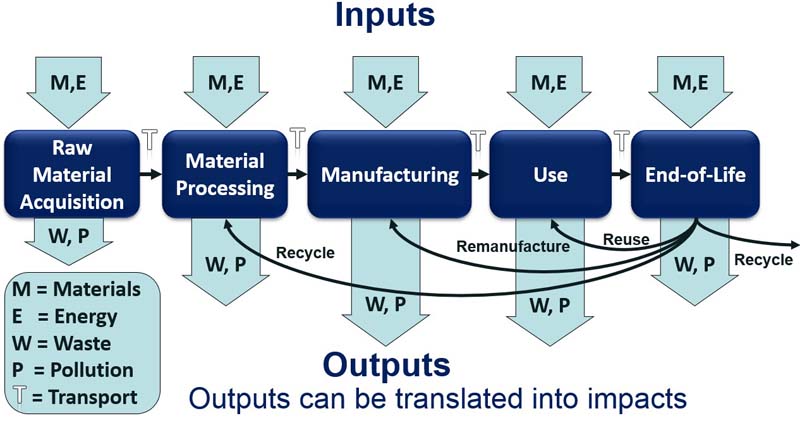A Primer On Pavement Life Cycle Assessment
Principles and Purpose of LCA
LCA provides a comprehensive approach to evaluating the total environmental burden of a particular product (such as a ton of aggregate) or more complex systems of products or processes (such as a transportation facility or network), examining all the inputs and outputs over its life cycle, from raw material production to the end of the product's life. A generic model of the life cycle of a product for LCA is shown in figure 1. As can be seen, the life cycle begins at the acquisition of raw materials, proceeds through several distinct stages including material processing, manufacturing, use, and terminates at the end-of-life (EOL) (Harvey, Meijer, and Kendall 2014).

Figure 1. Generic life cycle of a production system for LCA (Kendall 2012).
LCA can be used for a variety of purposes, including:
- Identifying opportunities to improve the environmental performance of products at various points in their life cycle.
- Informing and guiding decision makers in industry, government, and non-governmental organizations for a number of purposes, including strategic planning, priority setting, product or process design selection, and redesign.
- Selecting relevant indicators of environmental performance from a system-wide perspective.
- Quantifying information on the environmental performance of a product or system (e.g., to implement an eco-labeling scheme, make an environmental claim, or produce an environmental product declaration statement).
The LCA Process
LCA invites practitioners to take a systems approach that includes the full life cycle of a material, product, pavement or pavement system; in other words, a "cradle to grave" approach. However, it should be noted that LCA can also be applied to only certain or selected stages of the life cycle (for example, "cradle to gate"), depending on the goals and objectives of the life-cycle assessment. For pavements, the life cycle is typically defined to include the material extraction and production, construction, use, maintenance and rehabilitation (M&R), and end-of-life (EOL) phases. In LCA, these are referred to as life-cycle stages (or phases), and the inputs and outputs are referred to as "environmental flows." Each of these stages are affected by the pavement design, which results in the selection of structural capacity and materials that, along with construction quality, determine the performance of the pavement for the given traffic, climate, and native soil. The general LCA process is described and governed by the ISO 14040 series. The overarching requirements and guidelines are presented in the ISO 14044 "Environmental management - Life cycle assessment - Requirements and guidelines". From this standard, and as shown in figure 2, an LCA study consists of four phases:
- Goal and scope definition: The first phase of an LCA determines key features of the analysis including the depth and the breadth of an LCA, which can differ considerably depending on the overall goal. The scope of an LCA defines the system boundary of analysis (essentially, what life-cycle stages and processes are included in the LCA), the geographic and temporal boundaries of analysis, the functional unit of analysis, and also determines the required quality of data. Again, all of these depend on the subject and the intended use of the LCA.
- Inventory Analysis: The second phase of an LCA, is the accounting stage where environmental flows (inputs of material, energy, and resources, and outputs of waste, pollution, and co-products) are tracked for the system being studied.
- Impact Assessment: The purpose of this phase is to better understand the environmental significance of the LCI by translating environmental flows in to environmental impacts that are presented in different impact categories, typically: impacts to people (humans), impacts to nature (ecosystems), and depletion of resources. LCA studies usually include a selection of impact categories that are most relevant to the specific project goal and scope, and can range from narrowly focusing on energy and energy-related emissions to a full set of impact categories.
- Interpretation: This is the last phase of the LCA procedure, in which the results are summarized and discussed as a basis for conclusions, recommendations, and decision making in accordance with the goal and scope definition.

Figure 2. Life cycle assessment framework (Kendall 2012).
See Chapter 10 (.pdf, 5 mb) of the Reference Document for more details.
References
Harvey, J., J. Meijer, and A. Kendall. 2014. Tech Brief: Life Cycle Assessment of Pavements. FHWA-HIF-15-001. Federal Highway Administration, Washington, DC.
Kendall, A. 2012. Life Cycle Assessment for Pavement: Introduction. Presentation in Minutes, FHWA Sustainable Pavement Technical Working Group Meeting, April 25-26, 2012, Davis, CA.

